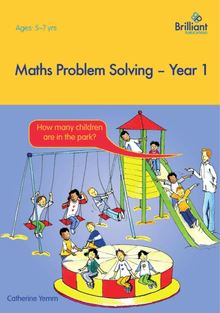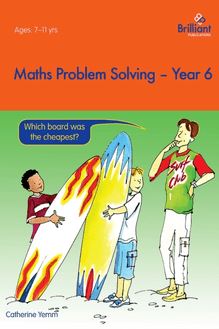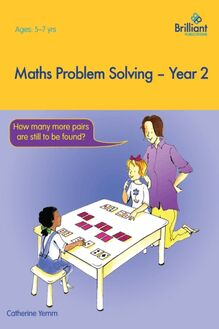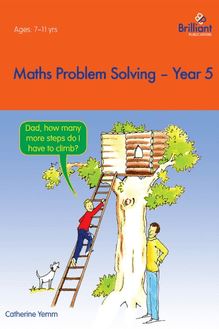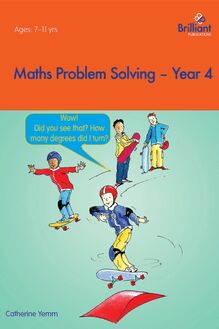Maths Problem Solving Year 2 , livre ebook
187
pages
English
Ebooks
2012
Vous pourrez modifier la taille du texte de cet ouvrage
Obtenez un accès à la bibliothèque pour le consulter en ligne En savoir plus
Découvre YouScribe et accède à tout notre catalogue !
Découvre YouScribe et accède à tout notre catalogue !
187
pages
English
Ebooks
2012
Vous pourrez modifier la taille du texte de cet ouvrage
Obtenez un accès à la bibliothèque pour le consulter en ligne En savoir plus
Publié par
Date de parution
10 mai 2012
Nombre de lectures
3
EAN13
9780857475169
Langue
English
Poids de l'ouvrage
2 Mo
Publié par
Date de parution
10 mai 2012
EAN13
9780857475169
Langue
English
Poids de l'ouvrage
2 Mo
Title page
Maths Problem Solving
Year 2
Catherine Yemm
Copyright page
Published by Brilliant Publications
Unit 10, Sparrow Hall Farm, Edlesborough,
Dunstable, Bedfordshire LU6 2ES
E-mail: info@brilliantpublications.co.uk
website: www.brilliantpublications.co.uk
General enquiries:
Tel: 01525 222292
The name Brilliant Publications and its logo are registered trade marks.
Written by Catherine Yemm
Cover and illustrations by Frank Endersby
© Catherine Yemm 2005
First published in 2005. Reprinted in 2010.
Digital version converted and published in 2012 by
Andrews UK Limited
www.andrewsuk.com
The right of Catherine Yemm to be identified as the author of this work has been asserted by her in accordance with the Copyright, Design and Patents Act 1988.
Certain indicated sections may be printed/photocopied by individual teachers for class use only, without prior permission from the publisher and without declaration to the Publishers Licensing Society. The materials may not be reproduced in any other form or for any other purpose without the prior permission of the publisher.
Introduction
Maths Problem Solving – Year 2 is the second book in a series of six resource books for teachers to use during the Numeracy lesson. It specifically covers the objectives from the Numeracy framework that are collated under the heading ‘Solving problems’. Each book is specific for a particular year group and contains clear photocopiable resources which can be photocopied onto acetate to be viewed by the whole class or photocopied onto paper to be used by individuals.
Problem solving plays a very important part in the Numeracy curriculum and one of the reasons Numeracy is such an important subject is because the skills the children learn enable them to solve problems in other aspects of their lives. It is not enough to be able to count, recognize numbers and calculate; children need to be able to use problem solving skills alongside mathematical knowledge to help them succeed in a variety of ‘real life’ situations. Many of the problem solving skills and strategies that are needed do not come naturally so they have to be taught.
Problem solving is not an area which should be taught exclusively on its own but one which should be taught alongside other mathematical areas such as numbers and shape, space and measures. Children will benefit from being given opportunities to solve problems in other areas of the curriculum and away from the classroom as well as in their Numeracy lessons.
When teaching children how to solve problems, the Numeracy strategy refers to a number of points that need to be considered: The length of the problems should be varied depending on the age group. Children will benefit from being given short, medium-length and more extended problems. The problems on one page or in one lesson should be mixed so that the children do not just assume they are all ‘multiplication’ problems, for example, and simply multiply the numbers they see to find each answer. The problems need to be varied in their complexity: there should be some one-step and some two-step problems, and the vocabulary used in each problem should differ. Depending on the age of the children the problems can be given orally or in writing. When given written problems to solve, some children may need help to read the words, although this does not necessarily mean that they will need help to find the answer to the question. The context of the problem should be meaningful and relevant to the children. It should attempt to motivate them into finding the answer and be significant to the time. For example, euros should be included as well as pounds.
This resource book is organized into four chapters: ‘Making decisions’, ‘Reasoning about numbers or shapes’, ‘Problems involving “real life”, money or measures’ and ‘Organizing and using data’. Each chapter contains six lessons, one to be used each half term.
Making decisions
The objective outlined under the ‘Making decisions’ heading of the Primary Numeracy Strategy for Year 2 children is: Choose and use appropriate operations and efficient calculation strategies to solve problems.
In this chapter the emphasis is on choosing and then using the correct operation to solve a given problem. In Year 2 the children are taught to add, subtract, multiply and divide and they should understand that different problems will need different methods to solve them. The children should be provided with an opportunity to tackle mixed problems so that they learn to think openly and make a decision depending on the vocabulary used and the question itself. If children are not taught these decisive skills then it is common for them to assume that, to find the answer to a question with two numbers, you just add the numbers. The questions set out in this chapter are arranged according to the skills the children will be practising each half term. In lessons 1, 3 and 5 the children will need to use their addition and subtraction skills to solve the problems. In lessons 2, 4 and 6 the children will need to use their multiplication and division skills. The questions the children will answer are designed to enable them to practise solving problems in a variety of relevant contexts.
When the children are completing the questions encourage them to think of the calculation they need to do and to write it down. They should also be encouraged to record what they use to work out the answer. For example:
Joshua has 24p and buys a book for 11p. How much change will he have?
I will need to
24–11
To help me I will use
some counters
The answer is
13 pence
The problem solving objectives are closely linked to the group of objectives that come under the heading ‘Checking results of calculations’. During the plenary session the children should be encouraged to check their answers by repeating additions in a different order or checking with an equivalent calculation.
Reasoning about numbers or shapes
The objectives outlined under the ‘Reasoning about numbers or shape’ heading of the National Numeracy Strategy for Year 2 children are as follows: Solve simple mathematical problems or puzzles; recognize and predict from simple patterns and relationships. Suggest extensions by asking ‘What if?’ or ‘What could I try next?’ Investigate a general statement about familiar numbers or shapes by finding examples that satisfy it. Explain methods and reasoning orally.
The activities are a mixture of problems, puzzles and statements. Lessons 1, 3 and 5 are related to shape while lessons 2, 4 and 6 are related to number. When given a statement such as: ‘If you take an odd number away from 5 you get an even number’, the children should be encouraged to provide examples to prove the statement, eg 5 − 3 = 2 or 5 − 1 = 4 . Others may be more obvious questions that just need an answer. The teacher should try to spend time talking to the pupils while they are working to allow them to explain their methods and reasoning orally and to provide an opportunity to ask question such as ‘What if …?’ The plenary session at the end of the lesson also provides an opportunity to do this.
Problems involving ‘real life’, money or measures
The objectives outlined under the ‘Problems involving ‘real life’, money or measures’ heading of the National Numeracy Strategy for Year 2 children are as follows: Use mental addition and subtraction, simple multiplication and division, to solve simple word problems involving numbers in ‘real life’, or money or measures, using one or two steps. Explain how the problem was solved. Recognize all coins and begin to use £.p notation for money (for example, know that £4.65 indicates £4 and 65p). Find totals, give change, and work out which coins to pay.
The activities in this chapter are typically ‘word problems’. The contexts are designed to be realistic and relevant for children of Year 2 age. The questions involve the operations of adding, subtracting, multiplication and division and the questions deal with money, measurements and everyday situations. There is progression within the chapter in accordance with the NNS sample plans. At first the questions are all one-step problems; they later include two-step problems. The operations needed to solve the problems have been chosen to reflect other skills being practised in each particular half term.
Term
Questions
Autumn – 1st half
+ and − one-step problems
Autumn – 2nd half
× and ÷ one-step problems
Spring – 1st half
+ and − one-step problems
Spring – 2nd half
× and ÷ one-step problems
Summer – 1st half
+ and − two-step problems and × and ÷ one-step problems
Summer – 2nd half
+ and − two-step problems and × and ÷ one-step problems
The teacher should try to spend time talking to the pupils while they are working to allow them to explain their methods and reasoning orally. The plenary session at the end of the lesson also provides an opportunity to do this.
The
